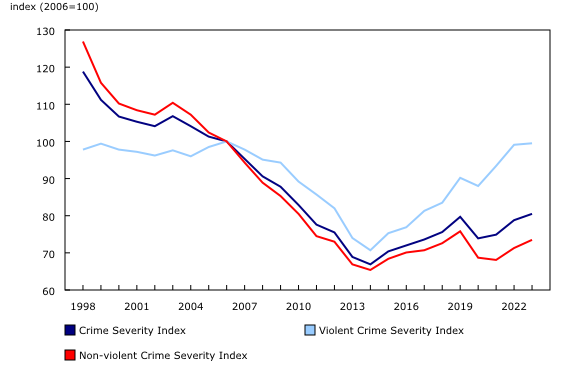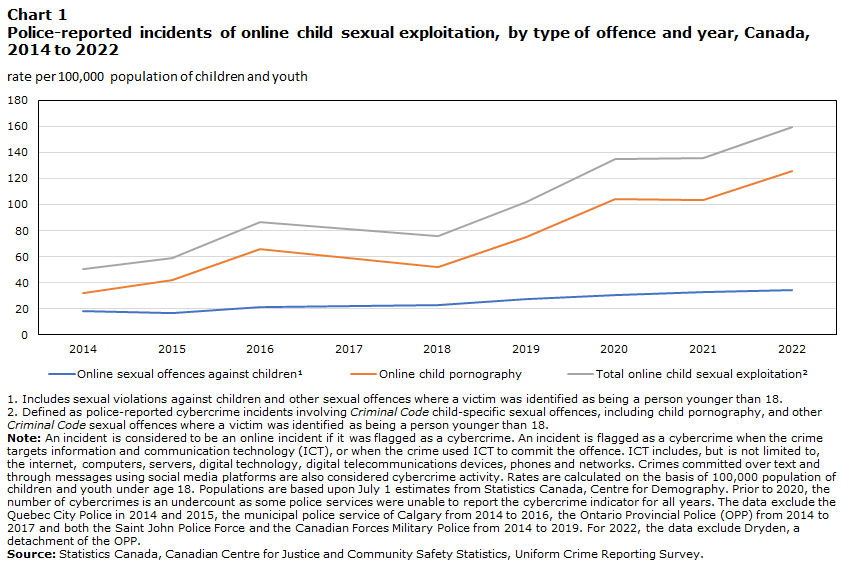Statistics Canada recently released its figures for the Crime Severity Index (CSI) for 2023. Data shows the rate rose 2.1 per cent between 2022 and 2023, which translates to a rate of 80.5 per 100,000 people.

This is the highest the CSI has been since 2010, but well below when reported numbers peaked in the late 1990s.

Homicides were down in the majority of provinces, with Manitoba reporting a decrease of 15 from the year before. Both robberies and vehicle thefts increased by five per cent, but when compared to longer-term data, down more than 50 per cent from 25 years ago.
The biggest contributors to the increase was a 35-per cent increase in rates of extortion, a 32-per cent increase in hate crimes, and a 52-per cent higher rate of police-reported instances of child sexual exploitation (CSE).

Get daily National news
British Columbia accounted for 79 per cent of that increase, while Alberta made up 14 per cent. Manitoba’s number of cases came down slightly.
From 2014 to 2022, reported cases of CSE have increased by 217 per cent across Canada. That figure didn’t surprise Manitoba RCMP Cpl. Gord Olson with the Internet Child Exploitation Unit (ICE).
“We’ve been inundated over the last few years since COVID, really,” Olson explained. “From luring cases, to making and distributing child pornography cases… unfortunately I’m not surprised that the numbers are high nationally.”
In Manitoba there have been 609 instances of CSE between 2018 and 2022, with 411 perpetrators being identified within the same time period.
Olson also made it clear that it’s not just one specific gender that is being primarily targeted by abusers.
“Our clients, if you will, are between 11 and 15 (years old) predominately female but we do have investigations involving males,” said Olson. “Males tend to be in the sextortion type of investigation, where the females are more apt to be onto the luring, where they’re being asked for pictures, and maybe to meet up to have a sexual encounter.”
There are ways to protect children. Olson says the most important thing parents can do is have honest conversations when it comes to online safety. Paul Davis, a social media and online safety educator, tends to agree, saying another key aspect is parents understanding what types of technology their children use, and how they interact with others online.
“The importance of understanding how kids use technology, and the risks are important regardless of your background,” Davis said. “Where you live, your community size… Please never have a false sense of ‘my kid’s OK’.”
Davis travels across the country speaking at schools and talking to parents. He explained to Global News that his presentation is all rooted in data as a way to provide the context to kids why online safety is so important.
Three foundational pillars Davis pushes for parents to adopt include: no online devices in the bedroom, no smartphones until at least Grade 8 unless it’s for medical reasons, and no social media before the age of 13.
“If parents implement those simple rules, the ability for a child to be hurt, cyberbullied, or witness pornography just dropped like rocks,” Davis stated. “At the end (of my presentation) I tell them where they should be online. Coding, blogging, podcasting, app-development, robotics — all the amazing things you can be doing online.”
Law enforcement have a greater arsenal of tools available to fight instances of CSE, including those that involve AI-generated content.












Comments